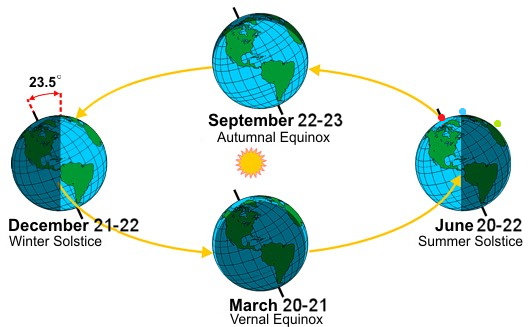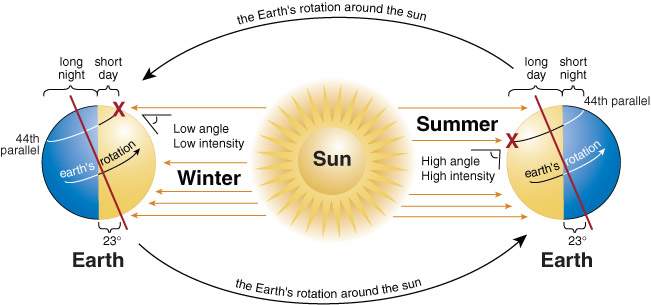e·qui·nox/ˈekwəˌnäks/
The equinoxes are the time of year that the sun crosses the equator as it moves in its path from north to south and back again during the year. The equinox is an
The equinox marks the first day of spring (vernal equinox) in March and the first day of fall (autumnal equinox) in September. On the equinox the sun rises directly in the east and sets directly in the west. And since the sun is lined up with the middle of the earth as opposed to either mostly in the north or mostly in the south, this gives the earth mostly equal day and night at this time of year. More so the closer to the equator you are.


Why We Have Seasons
Now, to understand why the sun would be in the north part of our sky or the south part of our sky instead of straight overhead you have to understand that the earth is tilted at an angle of 23.5 degrees. It stays in this orientation no matter where it is in its rotation around the sun.
So sometimes the top (north) half of the world is pointed more directly at the sun. For the other half of the Earth’s rotation around the sun, or the other half of the year, the bottom (south) half of the world is pointed more directly at the sun. This orientation and the tilt of our Earth’s axis is what gives us the seasons of the year, and why the nearer to the equator you are the seasons are much less distinct.
As the sun continues on its elliptical orbit around the sun the amount of sunlight and the angle of the sun in the sky will change daily sending the earth either into longer hotter days or shorter cooler days. Part of the reason the summer days are so much warmer and winter days are so much cooler is because of the angle of the sun to the earth. When the earth is tilted toward the sun, whether northern or southern hemisphere, the angle of the sun’s rays to that part of the earth is much more direct and focused. When the earth is tilted away during winter, whether northern or southern hemisphere, the angle of the rays of the sun are much more oblique and dispersed. Great demo during this video at https://www.youtube.com/watch?v=OR8EQ0DWpPw&t=378s

The sun will travel its path to the far end of the elliptical. The time of year marked upon reaching the farthest point of its eliptic rotation around the sun would either be the longest day of summer or shortest day of winter. Summer solstice, the longest day of summer, would occur in the hemisphere of the earth tilted toward the sun. The shortest day of the year, winter solstice, would occur in the hemisphere tilted away from the sun.
The sun’s rays are at its most oblique angle to that part of the earth at that point in the Earth’s rotation around the sun. Creating short, cold days. The farther from the equator you are the more pronounced these changes in length of day will be. At the North Pole on summer solstice there is 24 hours of day light. On winter solstice, the North Pole is at its farthest tilt away from the sun hiding it from the sun’s reach and leaving it in
Why is Equinox Important?
OK, so we’ve established why the equinox occurs. Why is this important? Well, since people have been keeping records, they have been tracking the sun’s motion across the sky. The equinoxes mark the changing of seasons, and were tracked and noted by ancient people for many reasons. Mostly, I am sure, so they could attempt the timeless and entertaining pursuit of trying to get an egg to stand on end (Equinoxes and Eggs)! However, we’ll discuss some other interesting theories in this article; Why the Ancients Remember the Equinox.
References
https://www.dictionary.com/browse/equinox
Image, https://www.livescience.com/31264-season-season-earth-equinoxes-solstices-infographic.html
Geoff Gaherty, Equinox Explained; Why Earth’s Seasons will change on Sunday,https://www.space.com/22852-fall-equinox-earth-seasons-explained.html, c. September 18, 2013
Laura Geggel, Winter Solstice Explained, https://www.livescience.com/57280-winter-solstice-science-explained.html, c. 2018
J. McKim Malville, Prehistoric Astronomy in the Southwest, pg 36, c. 2008
Sun rotation image; https://permaculturenews.org
Solar Schoolhouse, You Tube, June 2001
